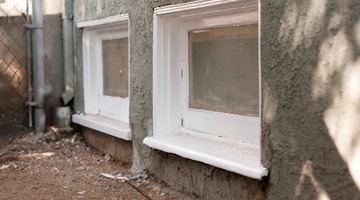How to Remove Mold on Window Sills
Mold is almost a fact of life with home ownership. An example of how and where mold can appear is on window sills. An exterior sill might lack proper drainage, or an older window sill might not be well-sealed and admit moisture into the interior sill.

Given plenty of rain and some dark conditions, either situation will cause mold that needs to be removed before it can damage your woodwork or create an unsightly mess.
Things You Will Need
- White vinegar or borax
- Pail
- Scrub brush
- Old rags
Warning
Removing mold is only the first step in addressing your problem. Mold thrives in dark, moist conditions. Eliminating the cause of your mold problem is the next step, lest you suffer a recurrence.
-
Consider your options for an antiseptic agent before mixing your mold-remover. Bleach is the standard choice, but it is also a harsh, toxic subject that may prove hazardous if used indoors and kill desirable plants if used outdoors. One good option is borax. Another more natural option is white vinegar.
-
Open the window before beginning your work. This will make sure there aren't any patches of mold hiding just out of sight, as well as providing good ventilation if you are working indoors.
-
Make your mold-remover in a pail. If you are using white vinegar, pour it right in with no changes. If you chose borax, mix in 1 cup per gallon of water.
-
Scrub the window sill with your mold-remover. Let the resulting scummy mix of mold and remover stand for a few minutes. While you are doing that, empty your pail (or get a new one) and refill it with clean water.
-
Return to the window sill and rinse it using an old rag and water. Use a new, fresh rag to dry the formerly moldy area.





The Drip Cap
- Mold is almost a fact of life with home ownership.
- Another more natural option is white vinegar.
- If you are using white vinegar, pour it right in with no changes.
- Scrub the window sill with your mold-remover.
References
Photo Credits
- Nathanael Turner/Demand Media
- Nathanael Turner/Demand Media
- Nathanael Turner/Demand Media
- Nathanael Turner/Demand Media
- Nathanael Turner/Demand Media
- Nathanael Turner/Demand Media
- Nathanael Turner/Demand Media
More Articles



